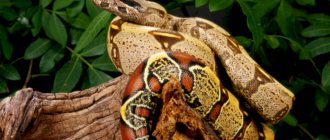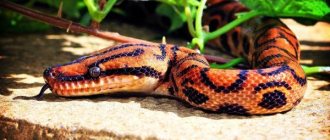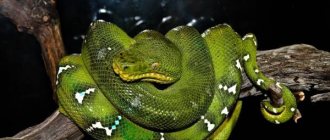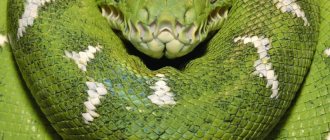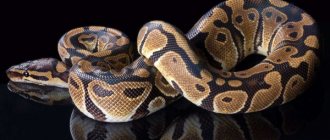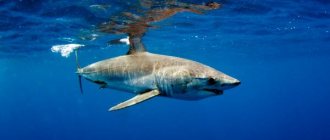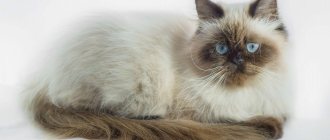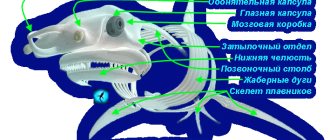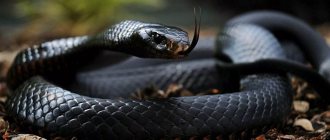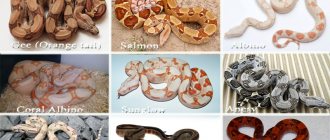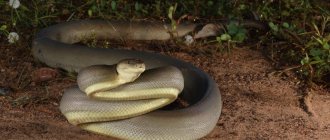- Wild animals
- >>
- Reptiles
Looking at this boa constrictor lifts your spirits, because its refreshing, rich, green color is incredibly invigorating and pleasing to the eye. For many terrarium keepers, the dog-headed boa constrictor is just a godsend, so almost every one of them dreams of having a beautiful boa constrictor in their collection. Let's analyze all the essential aspects of the life activity of this reptile, starting from external data and ending with the status of its population.
Origin of the species and description
Photo: Dog-headed boa constrictor
The dog-headed boa is also called the green tree boa. They also refer to it as an epithet like emerald. This reptile is not poisonous and belongs to the family of pseudopods, to the genus of narrow-bellied boas. The coloring is dominated by a general, juicy, bright green tone, which gives the boa constrictor attractiveness and extravagance. In Latin this boa constrictor is called Corallus caninus. The genus Corallus consists of three species groups, distinguished by various criteria. The dog-headed boa constrictor is included in one of these groups.
Video: Dog-headed boa constrictor
It was first discovered to the world by the famous Swedish scientist Carl Linnaeus, who gave a description of this reptile back in the 18th century. Due to the fact that the cubs of this snake are born coral-colored, the species was classified in the genus Corallus, giving it the adjective “caninus”, which means “dog-like”.
It is clear why the boa constrictor is called arboreal; it leads such a lifestyle, preferring to do almost everything without leaving the branches. It is considered emerald because of its beautiful color. The question arises: “Why is the reptile nicknamed the dog head?” The answer is simple - its head is shaped like a dog's, especially if you look at it from the side. The long teeth located on the upper jaw are also similar to the fangs of a dog.
Interesting fact: The length of the teeth of a green tree boa can be from 4 to 5 cm, so its bite is very traumatic, although not poisonous.
As for the dimensions of the reptile, they are not as large as its teeth; the average length of the body of a boa constrictor can range from 2 to 2.8 m.
Notes
- Ananyeva N. B., Borkin L. Ya., Darevsky I. S., Orlov N. L.
Five-language dictionary of animal names. Amphibians and reptiles. Latin, Russian, English, German, French. / under the general editorship of academician. V. E. Sokolova. - M.: Rus. lang., 1988. - P. 276. - 10,500 copies. — ISBN 5-200-00232-X. - "Boa manditra." Integrated Taxonomic Information System. Retrieved July 10, 2008.
- ↑ 1234
abcde Mehrtens JM. 1987. Living Snakes of the World in Color. New York: Sterling Publishers. 480 pp. ISBN 0-8069-6460-X. - abc McDiarmid RW, Campbell JA, Touré T. 1999. Snake Species of the World: A Taxonomic and Geographic Reference, vol. 1. Herpetologists' League. 511 pp. ISBN 1-893777-00-6 (series). ISBN 1-893777-01-4 (volume)
- Sanzinia madagascariensis at the IUCN Red List. Accessed 10 July 2008.
- 1994 Categories & Criteria (version 2.3) at the IUCN Red List. Accessed 10 July 2008.
- ^ Sanzinia madagascariensis at CITES and United Nations Environment Program / World Conservation Monitoring Center. Accessed 10 July 2008.
- Arslan H. Valeev, Dmitrii A. Antonov.
First Breeding of Sanzinia madagascariensis (Serpentes: Boidae) in Russia (English) // Russian Journal of Herpetology. — 2013-06-28. - Vol. 20, iss. 3. - P. 241–246. — ISSN 1026-2296.
Appearance and features
Photo: Dog-headed boa constrictor
The body of the dog-headed boa constrictor is quite powerful, slightly flattened on the sides. The head is large with a blunt muzzle and round eyes. The pupils of a reptile are located vertically.
Interesting fact: The boa constrictor's muscles are well developed, because when hunting, it uses an effective choke hold, from whose tight embrace it is impossible to escape.
Pseudophods are so named because they have residual forms of hind limbs (rudiments), they are claws protruding from the edges of the anus. This family has rudiments of pelvic bones and lungs, and the right organ is often longer than the left. The teeth of the boa constrictor are very strong and curved back, they grow on the palate and pterygoid bones. The huge teeth of the movable upper jaw protrude forward, so they do an excellent job of holding any prey, even those heavily covered with feathers.
The coloring of the dog-headed boa is, first of all, an unsurpassed camouflage. It does not always have a rich light green color; there are specimens of deep green, closer to the color of olives or emerald, some, on the contrary, have a lighter tone. The predominant green color is diluted with splashes of white located on the dorsal part. In some reptiles these white spots occupy a sufficient area, in others they are completely absent, and there are also specimens with black spots on the back. A rarity is the presence of a color mix consisting of black and white inclusions. The belly of a boa constrictor has a dirty whitish color with some yellowness, and maybe light yellow.
Baby snakes are born:
- reddish;
- orange-red;
- deep red;
- coral;
- reddish brown.
After some time, the babies turn green, becoming a copy of their parents. Males are smaller in size than females, they look a little smaller. Whatever you say, dog-headed boas are extremely beautiful, thanks to their exquisite and unusually bright grass coloring.
The reticulated python is the longest snake in the world
Until recently, the reticulated python was considered the second largest snake in the world fauna after the giant anaconda.
The reticulated python (Broghammerus reticulatus) is probably the longest snake in the world. The largest individuals of the nominate subspecies can reach a length of 10 m or more. However, individuals with a length of 4-8 m are more common. A record specimen of a reticulated python that lived in one of the zoos, according to unconfirmed data, reached a length of 12.2 m.
The reticulated python from the Philippines, 14 m 85 cm long and weighing 447 kg, which was reported in the media, was actually half that size. Reliably the largest reticulated python kept in captivity is a female over 7.5 m long named “Samantha”, caught in Borneo and died in 2002 at the Bronx Zoo (New York).
Reticulated pythons that live on small islands are significantly smaller than their mainland relatives and pythons from larger islands.
It got its name “reticulated” because of the complex pattern on the body, which includes a chain of light diamond-shaped spots in the middle of the back and triangular, interconnected dark spots with light centers on the sides. The head is light. Scales with a strong rainbow tint.
In the jungle, this reptile is almost impossible to see. The python can move easily and unnoticed between fallen tree trunks and tropical vegetation, and the color combination helps camouflage itself when catching prey.
The reticulated python is widespread in South and Southeast Asia. Pythons are most often found in humid forests and jungles. This species is one of the best swimmers, so they like to live near rivers and lakes. A few years ago, a reticulated python was also spotted in residential areas of Bangkok.
This large and aggressive snake can pose a certain danger to humans. There are several known cases of reticulated pythons attacking people, some of them fatal. Typically, a python will not attack such large prey as an adult because it will not be able to swallow it later, but large specimens can be potentially dangerous to children and adolescents. Even though this variety is the longest in the world, it is not heavy. Even a 7 meter python weighs approximately 65-75 kg, which is very little compared to its length.
The longest snake in the world feeds on a variety of vertebrates: monkeys, small ungulates, civets, rodents, birds, and reptiles. Often attacks domestic animals: goats, pigs, dogs and poultry. Common prey can be young pigs and goats weighing up to 10-15 kg. There is a known case in Borneo where a reticulated python 6.95 m long swallowed a female Malayan bear weighing 23 kg, as well as cases of pythons eating pigs weighing more than 60 kg. Sometimes it hunts bats, which it catches right in flight, catching its tail on uneven surfaces on the walls and ceiling of the cave.
To digest prey weighing about 30 kg, a python will need as much as 10 weeks. In most cases, they catch large prey and hide for many weeks until they become hungry again. Since pythons are good hunters, it is not difficult for them to find food.
The female python lays from 10 to 100 eggs, after which she curls up around the clutch, warming and protecting the eggs from predators. Incubation at an optimal temperature of +31-32 °C lasts an average of 88 days. Young pythons are about 60 cm long when hatching.
Many people confuse boas and pythons, but there are big differences between them. First of all, pythons lay eggs and hatch eggs, while boas are ovoviviparous.
Because of their edible meat and valuable skin, a very large number of pythons around the world were exterminated before laws to protect them came into force. Nowadays these snakes are often kept in zoos and terrariums. This snake breeds well in captivity, and several color morphs of the reticulated python have been developed and established through selective breeding. The maximum lifespan of a reticulated python in captivity is 21 years.
Scientific classification: Kingdom: Animals Type: Chordata Class: Reptiles Order: Squamate Family: Pythons Genus: Broghammerus Species: Reticulated python (lat. Broghammerus reticulatus (Schneider, 1801))
Where does the dog-headed boa live?
Photo: Dog-headed boa constrictor
The dog-headed boa constrictor is a very exotic person, with permanent residence on the territory of the South American continent.
It is found in the following areas:
- Venezuela;
- Guyana;
- French Guiana;
- Suriname;
- northeastern Brazil;
- Bolivia;
- Colombia;
- Ecuador;
- Peru.
The reptile prefers tropical, lowland, forest areas with high humidity, where it settles on both the first and second tiers of trees. Boas also inhabit wetlands. They prefer not to climb to a height of more than 200 meters above sea level, although individual specimens were also found at an altitude of about one kilometer. Green tree boas are widely distributed throughout the Canaima National Park, which is located in the southeastern part of Venezuela.
Moisture plays an important role in the life of green reptiles, so they often choose large river basins (for example, the Amazon) for their permanent locations. But the presence of a reservoir is not a necessary condition for their existence, it is just a preference. Boa constrictors also receive the moisture they need from precipitation, which in their places of residence receives up to 150 cm over a one-year period.
The home of boa constrictors is the crowns of trees, in which they spend most of their snake life, which is why they are called arboreal. And the life span measured for boa constrictors in the wild has not yet been precisely established, although in captivity it often exceeds the fifteen-year mark.
Now you know where the dog-headed boa constrictor lives, let's see what he eats?
Habitat
These snakes are not found in nature. Pythons live mainly in the Old World: Africa, Indochina, the Philippine Islands, Australia and Indonesia. Boas mainly live in the New World - in Latin America. But there are exceptions: some species inhabit the islands of New Guinea, Madagascar and Fiji.
Habitat - answer No. 2 to the question of how a boa constrictor differs from a python. But here it should be remembered that, despite the different geography, the habitat of these snakes is similar. Both boas and pythons love to hide from human eyes in thickets and thickets; There are woody species (usually colored green) and earthy ones (brown, brown, pockmarked).
What does the dog-headed boa eat?
Photo: Snake dog-headed boa constrictor
The question regarding the diet of dog-headed boas is very controversial. Many sources say that they feed only on birds that fly near reptiles. Herpetologists claim that this has not been scientifically proven; scientists report that the remains of mammals are often found in the stomachs of dead reptiles. There is another point of view regarding the menu of the dog-headed boa constrictor, which indicates its diversity; the snake, according to this opinion, hunts various living creatures:
- small monkeys;
- lizards;
- possums;
- bats;
- all kinds of rodents;
- birds (parrots and passerines);
- small pets.
Interesting fact: Boa constrictors hunt from ambush, hiding in the crown of trees, they hang on the branches. Once the prey is located, the green one makes a swift downward lunge to grab it straight from the ground. With the help of long teeth, the boa constrictor easily holds the caught victim in a canopy, using its signature choke technique. Sometimes it takes more than one hour to swallow the prey.
It has been noticed that young snakes live in a tier lower than their more mature counterparts, so lizards and frogs often serve as food for them.
Dog-headed boas living in captivity are often capricious, refusing food offered, so they have to be fed artificially. In a terrarium, green ones are switched to feeding on rodents. A mature individual is fed once every three weeks, and young people eat more often - every 10 or 14 days. The thickness of the rodent carcass offered to the boa constrictor should not be greater than the thickest part of the reptile, otherwise the snake will regurgitate an overly large snack. Accustomed to eating rodents, domesticated boas feed on them their entire lives.
Terrarium
Place branches in the boa constrictor's house so that he can climb on them. The fact is that in nature, snakes love to perch on branches and hunt - provide your pet with the same opportunity and he will feel “at home.”
Now about the soil. It should be either coconut shavings or peat flooring. In a good way, it is necessary to change the litter as it becomes dirty, but the tenant will not mind if you do this every 3-4 days. Who doesn't love cleanliness?
Maintain temperature control. Boas like it to be 28-30 degrees Celsius during the day and not drop below 22 at night. In addition, the terrarium should be humid. To do this you need to spray it. Be careful - there is no need to arrange tropical downpours, slush in the terrarium is bad. And even more so, do not make it rain on the snake itself - this will irritate it.
We are gradually approaching feeding your pet and here are the important nuances that you should know about:
- Do not overfeed the boa constrictor. Believe it or not, these animals also have a problem with obesity. But if for you and me it is solved by diets and physical activity, then for these creatures everything can end in tears. It is unlikely that you will force the snake to do exercises in the morning, so try not to overfeed it and everything will be fine.
- If, out of the kindness of your heart, you still overfeed the boa constrictor, then don’t expect any offspring!
- We feed the pet strictly according to schedule and in doses, despite the pleading hungry gaze of unblinking eyes.
Features of character and lifestyle
Photo: Teeth of a dog-headed boa constrictor
The dog-headed boa is the most arboreal of all the arboreal species. He spends all day and night on the branches, hunting, resting, eating, looking for a sexual partner, reproducing and even giving birth to offspring. The reptile wraps itself around the branch like a green spiral, its head lies along the twig, and half rings of its body hang from both sides. Almost the whole day, the body position remains unchanged. The tail of the boa constrictor is very tenacious and strong, so it is not in danger of falling; it can maneuver deftly and with lightning speed in the thick of the crown.
Arboreal reptiles begin to be active at dusk, and spend the day in the shady crown. Sometimes they descend to the ground, doing this in order to sunbathe. Snakes detect potential prey thanks to their acute vision and temperature-sensitive receptor pits located above the upper lip. Reptiles use their forked tongue as a scanner, checking the space around them. Boas use all these devices because... they poorly detect sounds, having no auditory openings on the outside and having an underdeveloped middle ear, however, this is characteristic of all snakes.
The boa constrictor from the terrarium is also located on specially equipped branches and begins to eat when it gets dark. The process of molting in emeralds occurs two or three times annually. The very first time small boas molt is just a week after birth.
If we talk about the character of this reptile, then it is not as attractive as its appearance. It has been noticed that reptiles living in a terrarium have a rather bad character, they are picky and very selective when it comes to food, and they can bite so hard with their long teeth that sometimes they even affect the nerves. The attack occurs at lightning speed and is repeated more than once. So, it is better for inexperienced naturalists not to pick up a doghead, because you need to know how to hold it correctly.
Texas snake
What is the name of the white snake? Another name for the snake is the white rat snake. This formulation is directly related to its diet and some external resemblance to rodents. This type of reptile is considered a very rare species.
Representatives of this species of chordates do not release a toxic substance when bitten. However, liquid from the fangs can cause a slight allergy.
When in contact with external irritants, the white-headed snake delivers a sharp blow, which is accompanied by painful sensations for several days.
During the molting period, reptiles are characterized by increased aggressiveness. The average lifespan of a Texas rat snake is 15 to 20 years with proper care and maintenance.
Social structure and reproduction
Photo: Dog-headed boa constrictor
Female dog-headed boas do not lay and incubate eggs, because they are ovoviviparous. Males become sexually mature closer to three or four years of their life, and females a little later - around four or five. The wedding snake season begins in December and continues through March.
All mating games, dates and copulations take place right in the treetops. During this period, the boas have no time for food, the gentlemen hover around the lady of the heart, trying to win her over in their direction. Often duels occur between them, in which the victorious groom is revealed, and he gets the young lady’s heart.
Interesting fact: The duelists attack each other, using a whole series of mild bites and pushes, identifying the strongest opponent, who will excite the lady of the heart by rubbing against her body and lightly scratching with the help of the rear claws (rudiments).
A female in position does not eat anything until the birth of her offspring. She can eat only in the first two weeks from the moment of conception. The embryos develop in utero, nourished by egg yolks. They leave the eggs while they are still inside the mother’s body, and at the moment of birth they are covered with a thin film, which is torn almost instantly. Newborn snakes are connected to the yolk sac by an umbilical cord, which breaks on the second to fifth day after birth.
The gestation period for cubs lasts from 240 to 260 days. One female gives birth to from 5 to 20 baby snakes (usually there are no more than 12). The weight of the babies ranges from 20 to 50 grams, and their length can reach up to half a meter. After the babies are born, the mother immediately leaves them, not caring at all about the babies. In the very first days, baby snakes are very vulnerable and can become easy prey for any predatory animals, so not everyone manages to survive.
As already noted, in most babies the color is predominantly reddish or red-brown, but there are also brighter specimens - lemon yellow and fawn, painted with brightly visible white spots on the dorsal part. As they grow up, the babies change their color scheme, becoming green, like their parents.
Terrarists begin to mate tree boas as early as two years of age, but their offspring are often weakened. Stronger and healthier babies are born to older boa constrictors. For active reproduction, the night temperature in terrariums is reduced to 22 degrees plus. In addition, before this process, the female is often kept separately from the male. This is a troublesome and difficult task, so you need to have experience and skill.
Interesting Facts
- Boa constrictors strangle their victims using the following technique: by wrapping themselves around the chest of the prey, the boa constrictor “tightens” its rings on its chest as it exhales. As a result of 2-3 exhalations, the victim has almost no air left in his lungs, and he can no longer breathe.
- Boas, like other amphibians, are cold-blooded animals, i.e. their body temperature depends on the ambient temperature. The activity of boa constrictors also depends on this. The higher the temperature, the more active they behave. The best way to calm a boa constrictor is to lower the temperature in the terrarium.
- What distinguishes boas from other snakes is their ability to hunt in zero visibility. They have temperature-sensitive receptors located between the eyes and nostrils. These organs detect the heat emanating from the body of the intended victim at a considerable distance in complete darkness, allowing the boa constrictor to hunt at night as effectively as during the day.
- Most snakes use their tongue to collect particles present in the air, while the nostrils they have are used only for breathing. When the snake retracts its tongue, the particles are absorbed by special cavities on the roof of the snake's mouth, thus allowing it to perceive odors.
Video
https://youtube.com/watch?v=9EuHwH_Yq-c
Sources
- https://nashzeleniymir.ru/boa constrictor https://ru.wikipedia.org/wiki/Ordinary_boa constrictor https://www.vetprofy.ru/stati/ekzoticheskie-zhivotnye/udavy-opisanie-vidov-i-interesnye-fakty https:// www.nochnichok.ru/home/2014/07/29/udav-v-domashnih-uslovijah-gde-soderzhat-i-chem-kormit.htmlhttps://www.moscowzoo.ru/animals/reptilii/obyknovennyy-udav/ https://zoo-dom.com.ua/acatalog/379/120/593.htm
Natural enemies of dog-headed boas
Photo: Dog-headed boa constrictor in nature
The dog-headed boa constrictor is not overly large in size, like its other constrictor constrictors, or poisonous, but its teeth are very impressive, and the muscles of the body are extremely strong, so it can bite its opponent seriously, and it is not possible to get out of the suffocating embrace of the reptile. Living under a canopy of branches and green foliage helps the boa constrictor to remain unnoticed, because its beautiful color is, first of all, an excellent camouflage, helping both when hunting and to hide from the enemy.
Despite all the protective functions of the arboreal reptile listed above, it has plenty of enemies in natural conditions. A variety of animals can defeat a mature dog-headed boa constrictor.
Among them are:
- jaguars;
- large feathered predators;
- wild boars;
- caymans;
- crocodiles.
Newly born snakes have the most ill-wishers, because their mother leaves them immediately after they are born. Slightly older young animals are also very vulnerable, because does not have the proper experience and has not reached the required size. Young snakes often become victims of coyotes, kites, monitor lizards, jackals, hedgehogs, mongooses, and ravens. So, it is not easy for dog-headed boas to survive in harsh natural conditions, especially for those who are still very small and have not gained life experience as a snake.
Lifestyle
The serpent leads a “hanging” lifestyle. The tenacious tail is a hook that allows it to rush like an arrow towards the desired prey running along a tree or on the ground (even flying past), without falling from the tree. It grabs small animals with its huge teeth, squeezes it with a strong grip no worse than a Rottweiler, drags it up and swallows it whole. He suffocates her with the rings of his body so as not to create a fuss, and slowly swallows it. The diet includes small rodents, lizards, and bats. The main thing is that the “lunch” does not exceed the diameter of the widest part of the boa constrictor’s body. Otherwise, the snake may spit it out in anger.
